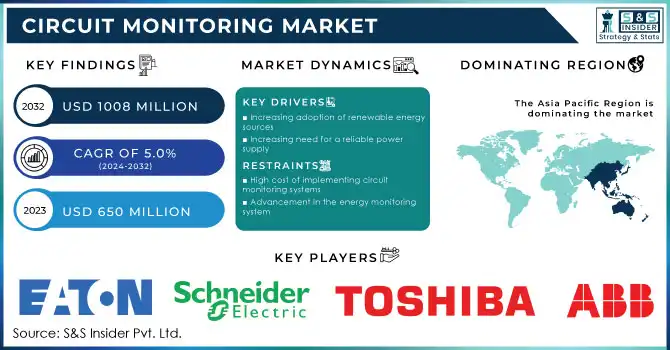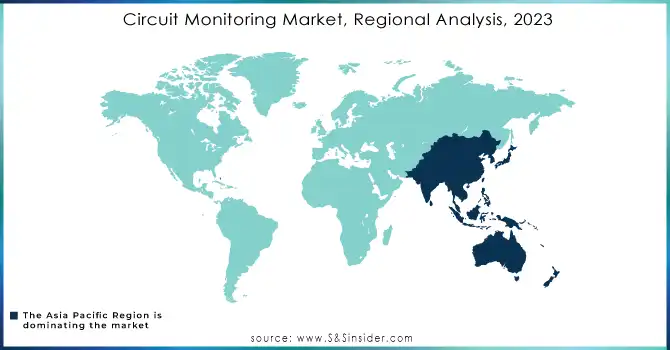Circuit Monitoring Market Key Insights:

Get More Information on Circuit Monitoring Market - Request Sample Report
The Circuit Monitoring Market size was valued at USD 650 Million in 2023 and is projected to reach USD 1008 Million by 2032, growing at a compound annual growth rate (CAGR) of 5.0% over the forecast period of 2024 to 2032.
Circuit monitoring is the process of observing and analyzing the performance of electrical circuits. It involves the use of specialized equipment to measure various parameters such as voltage, current, and frequency. The data collected from circuit monitoring can be used to identify potential issues and prevent equipment failure, thereby improving the overall efficiency and reliability of the system.
Effective circuit monitoring requires a thorough understanding of electrical systems and the ability to interpret complex data. It is a critical aspect of maintenance and safety in industries such as manufacturing, energy, and telecommunications. By implementing regular circuit monitoring, businesses can ensure that their equipment is operating at optimal levels and avoid costly downtime.
The Circuit Monitoring Market is essential for ensuring the safety and efficiency of electrical systems in various industries, including manufacturing, healthcare, and telecommunications. Circuit monitoring involves the use of specialized equipment and software to detect and analyze electrical signals. This allows for the identification of potential issues before they become major problems, reducing downtime and increasing productivity. As technology continues to advance, the Circuit Monitoring Market is expected to grow significantly. This growth will be driven by the increasing demand for reliable and efficient electrical systems, as well as the need for real-time monitoring and analysis.
Market Dynamics
Drivers
-
Increasing adoption of renewable energy sources
-
Increasing need for a reliable power supply
With the increasing reliance on technology and the internet, power outages can have a significant impact on businesses and individuals. Circuit monitoring systems can help to identify potential issues before they become major problems, allowing for proactive maintenance and repairs. This factor drives the market for circuit monitoring systems.
Restrain
-
High cost of implementing circuit monitoring systems
-
Advancement in the energy monitoring system
As technology continues to evolve, energy monitoring systems have become increasingly sophisticated. These systems are designed to provide real-time data on energy consumption, allowing businesses and individuals to make informed decisions about their energy usage. However, this advancement has created a problem for the circuit monitoring market. Circuit monitoring systems are designed to monitor the flow of electricity through a circuit. They are used to detect faults and other issues that could lead to electrical fires or other hazards. However, as energy monitoring systems become more advanced, they are able to perform many of the same functions as circuit monitoring systems. This means that businesses and individuals may be less likely to invest in circuit monitoring systems, as they can get similar information from their energy monitoring systems. This presents a challenge for the circuit monitoring market.
Opportunities
-
Increasing Government initiatives to reduce carbon footprints
-
Increasing number of cloud-based data centers
The growing number of cloud-based data centers presents a significant opportunity for the circuit monitoring market. This trend is driven by the increasing demand for cloud computing services, which require reliable and efficient circuit monitoring solutions to ensure optimal performance and security. As more businesses and organizations move their operations to the cloud, the need for advanced circuit monitoring technologies becomes more critical. These solutions enable data center operators to monitor and manage their circuits in real time, ensuring that they are operating at peak efficiency and minimizing the risk of downtime or data breaches. Moreover, the circuit monitoring market is poised to benefit from the ongoing shift towards edge computing, which involves processing data closer to the source rather than in centralized data centers. This trend is driving the need for more distributed circuit monitoring solutions that can be deployed at the edge of the network, providing real-time visibility and control over critical circuits.
Challenges
-
Fluctuation in the prices of raw material
Impact of COVID-19
The COVID-19 pandemic has had a significant impact on the circuit monitoring market. With the sudden shift to remote work and the increased demand for online services, the need for reliable and efficient circuit monitoring has become more critical than ever before. As businesses and organizations adapt to the new normal, they are increasingly relying on circuit monitoring solutions to ensure uninterrupted power supply and prevent downtime. This has led to a surge in demand for circuit monitoring products and services, as companies seek to safeguard their operations and maintain business continuity. Moreover, the pandemic has also accelerated the adoption of digital technologies, including cloud-based circuit monitoring solutions. This has enabled businesses to monitor their circuits remotely, reducing the need for on-site visits and minimizing the risk of exposure to the virus.
Impact of Russia-Ukraine War:
The war has caused disruptions in the supply chain of electronic components, which are essential for the production of circuit monitoring equipment. This has led to a shortage of these components and an increase in their prices, ultimately affecting the overall cost of circuit monitoring systems. Furthermore, the conflict has also resulted in a decrease in demand for circuit monitoring systems in the affected regions, as businesses and individuals prioritize their spending on more essential needs such as food, shelter, and safety. The more detailed impact is mentioned in the final report.
Impact of Recession:
Due to the current economic downturn, the demand for circuit monitoring systems has decreased due to the shifting of consumer behavior and businesses that are trying to reduce their spending. This has resulted in a decrease in sales and revenue for companies operating in this market. Furthermore, the recession has also led to a shift in priorities for many businesses. While circuit monitoring systems are important for ensuring the safety and efficiency of electrical systems, they are often seen as a non-essential expense during tough economic times. As a result, many companies have chosen to delay or forego investments in these systems altogether.
Key Market Segmentation
By Type
-
Modular Circuit Monitoring
-
Branch Circuits
-
Multi Circuits
By Application
-
Data centers
-
Residential
-
Commercial
-
Industrial
Regional Analysis
The Asia Pacific region dominated the circuit monitoring market and is expected to grow with a significant CAGR during the forecast period. This is owing to the region's robust economic growth, increasing demand for energy, and rapid industrialization. Furthermore, the Asia Pacific region has been investing heavily in the development of advanced technologies and infrastructure, which has led to the adoption of innovative circuit monitoring solutions. These solutions have helped businesses in the region to improve their operational efficiency, reduce downtime, and enhance their overall productivity. As a result, the Asia Pacific region has become a hub for circuit monitoring solutions, attracting both local and international players in the market. With its favorable business environment, skilled workforce, and supportive government policies, the region is poised to continue leading the circuit monitoring market in the years to come.
Europe is expected to grow with the highest CAGR during the forecast period of 2023-2030. This is attributed to the region's strong focus on energy efficiency and sustainability, as well as the increasing adoption of smart grid technologies. As the demand for reliable and efficient power distribution systems continues to rise, circuit monitoring solutions are becoming increasingly important. These solutions allow for real-time monitoring and analysis of power usage, helping to identify potential issues and optimize energy consumption. In Europe, there is a growing emphasis on reducing energy consumption and carbon emissions, with many countries implementing strict regulations and targets in this area. This has led to a significant increase in the adoption of smart grid technology, which rely heavily on circuit monitoring solutions. Furthermore, the region's strong industrial base and advanced infrastructure make it an attractive market for circuit monitoring providers.

Need any customization research on Circuit-Monitoring-Market - Enquiry Now
REGIONAL COVERAGE:
-
North America
-
USA
-
Canada
-
Mexico
-
-
Europe
-
Germany
-
UK
-
France
-
Italy
-
Spain
-
The Netherlands
-
Rest of Europe
-
-
Asia-Pacific
-
Japan
-
south Korea
-
China
-
India
-
Australia
-
Rest of Asia-Pacific
-
-
The Middle East & Africa
-
Israel
-
UAE
-
South Africa
-
Rest of the Middle East & Africa
-
-
Latin America
-
Brazil
-
Argentina
-
Rest of Latin America
-
Key Players
The major players are Eaton Corporation plc, Schneider Electric SE, ABB Ltd., Mitsubishi Electric Corporation, Bay Power, Toshiba International Corporation, Circuitmeter Inc., Legrand, Omron, Packet Power, and other players.
Recent Developments:
-
In February of 2022, Schneider Electric announced exciting enhancements to their EasyPact EXE vacuum circuit breaker series. This series is responsible for connecting building infrastructures, large commercial buildings, and industrial plants to the electricity grid.
-
In 2021, ABB India made a significant contribution to the electrical retail market with the launch of their Formula DIN-Rail. This complete range of Miniature Circuit Breakers (MCBs), Residual Current Circuit Breakers (RCCBs), and Isolators is estimated to be worth a staggering 250 million USD in India alone.
| Report Attributes | Details |
| Market Size in 2023 | US$ 650 Mn |
| Market Size by 2032 | US$ 1008 Mn |
| CAGR | CAGR of 5.0% From 2024 to 2032 |
| Base Year | 2023 |
| Forecast Period | 2024-2032 |
| Historical Data | 2020-2022 |
| Report Scope & Coverage | Market Size, Segments Analysis, Competitive Landscape, Regional Analysis, DROC & SWOT Analysis, Forecast Outlook |
| Key Segments | • By Type (Modular Circuit Monitoring, Branch Circuits, and Multi Circuits) • By End-user (Data centers, Residential, Commercial, and Industrial) |
| Regional Analysis/Coverage | North America (USA, Canada, Mexico), Europe (Germany, UK, France, Italy, Spain, Netherlands, Rest of Europe), Asia-Pacific (Japan, South Korea, China, India, Australia, Rest of Asia-Pacific), The Middle East & Africa (Israel, UAE, South Africa, Rest of Middle East & Africa), Latin America (Brazil, Argentina, Rest of Latin America) |
| Company Profiles | Eaton Corporation plc, Schneider Electric SE, ABB Ltd., Mitsubishi Electric Corporation, Bay Power, Toshiba International Corporation, Circuitmeter Inc., Legrand, Omron, Packet Power |
| Key Drivers | • Increasing adoption of renewable energy sources • Increasing need for a reliable power supply |
| Market Opportunities | • Increasing Government initiatives to reduce carbon footprints • Increasing number of cloud-based data centers |

